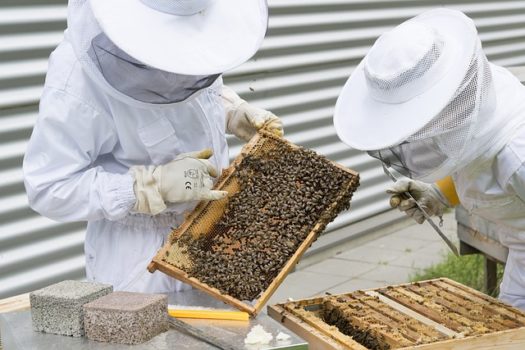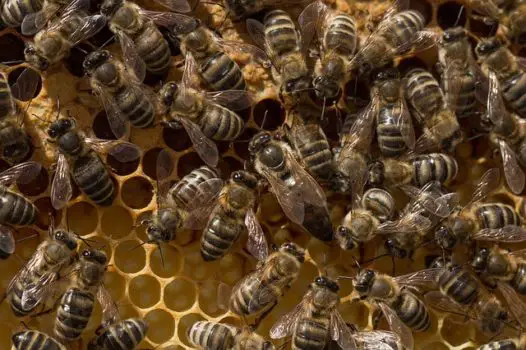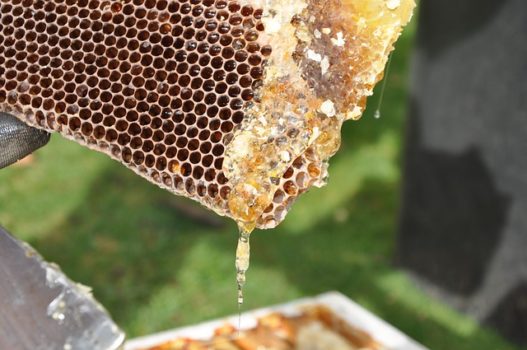In the increasing battle to raise honey bees there is a new variety on stage. The Saskatraz honey bee shows some amazingly good promise to do well in the battle against varroa mites and tracheal mites which are a component of colony collapse disorder. They also area a gentle, hearty, good production variety that can winter well.
I have had a colony of Saskatraz honey bees, and they are doing great. Let’s explore these honey bees and I’ll let you know my experience with them.
Saskatraz bees are newly available
The Saskatraz honey bee is relatively new on the scene of beekeepers. They are a result of extensive breeding programs where positive desirable traits were observed and bred into the Saskatraz bee. They have become commercially available to the public only in the last few years.
Most beekeepers have been using Italian, Carniolan, and Russian bees in their apiaries. These varieties have been susceptible to varroa mite, tracheal mite, and fungal issues such as American Foul Brood. Russian bees have shown some positive traits in the battle of the varroa mite. I have another article about them here. I have had Russian bees for a few years and really have enjoyed and done well with them.
Infestation of varroa mites and tracheal mites have resulted in the declining health and death of many honey bee colonies. It is also considered to be a factor in the increase of colony collapse disorder that’s plaguing many areas of the world. Colony Collapse Disorder has resulted in the decline of pollination and loss of crops. To put this into perspective, the honey bee is indirectly responsible for one third of the world’s food supply and 90 different plant species.
So, the decline of the honey bee has very real and drastic effect on human life.
What’s with the name Saskatraz?
If you’re like me, you might find the name Saskatraz interesting. It brings up the idea of Alkatraz prison, or some kind of crazy Tasmanian devil bee or something. The name actually comes from the apiary, or bee farm, where this strain of bee was developed. The apiary is located in Saskatchewan Canada.
The location was very remote and isolated form other beekeepers, growers, and possible contaminators of the development process. It kind of sounds like an isolated prison colony of bees. I have not been able to verify that the name is after the famous prison Alcatraz, but it does come to mind. The only information that I have definitively found for the name is that it’s the name of the apiary that these bees were developed in in Saskatchewan Canada.
History of the Saskatraz Honey Bee
The Saskatraz bees were developed by Meadow Ridge Enterprises Ltd. in collaboration with the University Saskatchewan and Queen breeders from Manitoba and Saskatchewan in Canada.
The goal was to get a bee that would combine all the good and beneficial traits of these colonies of honey bees. That way the bees could combat the issues naturally without miticides, while also being a gentle good pollinator and honey producer.
Miticides have been used for quite a while with limited results. My personal experience with miticides have been mixed. When I first used miticides they worked well. My bees were healthy and seemed fine. I was taught in a beginning beekeeping class that using a miticide was common and had always been done and was good for my hives. I used a more organic miticide and thought that was a good way to keep my honey bees safe and healthy. I did notice that over the years the miticide seemed to be pretty rough on my honey bees and weakened them. The cure for the mites seemed to be worse than the mites themselves.
The Saskatraz project was trying to get a strain of bee that you wouldn’t need to use any miticides and you could combat these pests naturally. What the beekeeping world is finding out is that the mites are growing tolerant to the miticides that are being used. The common practices of using a miticide with a mite infestation was creating a stronger mite resistant to the miticide. A better solution needs to be found as colony collapse disorder is becoming more and more common.

The Saskatraz project put together a powerhouse team of Doctors, Doctorate students, and successful honey bee queen producers to breed a strain of honey bee that could battle varroa mites, tracheal mites, viral, and fungal issues; but still be gentle and a good producer. To do this they got queens and drones from specific honey bee colonies in Russia, Germany, and Canada. The beekeepers had colonies of honey bees that had demonstrated good results with resistance to varroa mites, tracheal mites, and fungal issues.
They also needed to have a good variety and diversity of genetics to work with. With more diverse genetics the bees will hopefully be stronger and more virile as they are introduced to professional beekeepers and the general public.
The goal of the Saskatraz project is to create a super bee of sorts. The queens and drones were selected from these specific areas due to characteristics that the colonies displayed. The specific qualities of being resistant to varroa mites, tracheal mites, viral, and fungal diseases were observed and bred into different honey bee colonies.
It’s taken a few years of meticulous breeding and observation to come up with the strain of honey bee they were looking for. Through the Sakatraz project scientists and beekeepers were able to track the traits they wanted in the bees from these colonies from all over the world. The result is the Saskatraz bee.
There is a great site with all the technical information about the Saskatraz project here.http://www.saskatraz.com/index.htm
Attributes of Saskatraz bees
The Saskatraz bee has great characteristics. They are naturally resistant to varroa mites and tracheal mites. They aren’t perfectly immune but are much better at resisting the mites. Testing shows dramatically less, or no population of mites in a colony.
Saskatraz bees are more hygienic than other breeds of honey bees which could contribute to the lower occurrence of the mites. Testing is being done to see if it is the longer leg length attributing this aspect. Longer legs would allow the bees to reach more of themselves to clean off the mites.

Sascatraz bees are also showing good resistance to some of the fungal issues that plague beekeepers. Testing is still ongoing, but American foulbrood and chalk brood are also dramatically lower in occurrence, or non-existent in Saskatraz bee colonies.
Saskatraz honey bees are a gentile bee similar in temperament to Italian bees. They are good produces or honey and comb. The Saskraz honey bees are good producers of propolis, wax, and beebread. Generally, they have the same good characteristics of breeds commonly used by professional and hobby beekeepers.
If you would like to read more about the personality or temperament of Sakatraz bees, I wrote an in-depth article on the temperament of Sakatraz bees here.
My experience with Saskatraz bees
I have been keeping bees for a number of years now. My first few years with beekeeping were the golden years. I had both Italian and Carniolan bee colonies. They did amazingly well! I harvested 120 pounds of honey from 2 hives the first year I had them with plenty of honey left over for the bees to winter over.
Beekeeping became popular in my area and many hives showed up in the neighborhood. This concerned me, but I thought more bees meant better pollination, more honey and the world would be a better place.
Well, this explosion of beekeepers proved to be the opposite. It just became an ongoing spreading of mites. My hive soon showed a decline in health and an increase in mite infestation. I treated my hives and kept the health up for a while.
Eventually my hives experienced weakness and death. I would start a new hive with everything looking good and by harvest time in the fall the hives would be weak, and some would even swarm in the fall leaving an empty hive.
I tried Russian bees couple of years ago with good success. These seemed to have the same vigor as the bees I had the first time I started to try beekeeping with Italian and Carniolian varieties. The Russian hives produced well, but not quite as much as my Italian and Carniolian breeds.
I then was introduced to the Saskatraz bees. I had never heard about them and decided to do some research. They sounded a bit too good to be true, but really worth a try.
I got a bee package of a Saskatraz queen and 3 pounds of workers. The workers were Italian bees. I set up a hive in Late April.
The set up was done the same way I had installed bee packages in the past. I put the queen in the hive with a candy plug in her cage allowing the workers to eat the plug and free the queen. This takes some time, 24-48 hours generally, and allows the workers to bond with the queen.
I gently dumped the workers into the hive and let them work at establishing the hive and getting used to the pheromones of the queen as they freed her from her cage. This process has worked well in the past and the method many beekeepers use.
I monitored the hive closely and it progressed at the same rate that I was used to with other bee packages. The queen was accepted and laid a good tight pattern of eggs. The pattern of egg laying can give a good indication of the health of the queen. A tight pattern is a good indication of a healthy productive queen.
The brood was healthy, and the hive progressed well. I did notice that the Saskatraz bees seemed to create more propolis than I had experienced in the past with Italian and Carniolian breeds.
Propolis is amazing stuff. I have an article about bee propolis here. You can find out how bee propolis is important for the health of your hive and the battle against bacteria and viruses. These viruses and bacteria are thought to be contributors to colony collapse as well.
The hive did very well throughout the summer. I was concerned because my area experienced drought conditions and the availability of flowering plants was a bit limited compared to a normal water year. The Saskatraz colonies did just fine and thrived.
The Saskatraz hive produced plenty of comb, brood, bee bread, and were abundant in honey. I was surprised at the success of the colony. I usually need to leave most of the first seasons honey to get the new colony to survive. My Saskatraz bees produced enough honey for themselves and filled a full sized super beyond.
Where to get Saskatraz Bees
Olvarez Honey Bees are the exclusive distributer of Saskatraz bees in the United States. They however have become a distributor to other bee suppliers nationwide. I have seen that most honey bee providers have access to Saskatraz queens and can create a bee package for purchase. I will warn you to order them early. The Saskatraz bee is becoming very popular in the beekeeping world.

Summary
Saskatraz bees are a bee variety that has been bred to have some really amazing and beneficial traits:
- They are great honey producers.
- They resist varroa and tracheal mites.
- They have a resistance to fungal and viral problems that many beekeepers have experienced in their hives.
- They winter well.
Saskatraz honey bees seem to be a great bee for the commercial and hobby beekeeper. In my research some beekeepers had the experience that the Saskatraz hives were prone to swarming. I have yet to experience swarming issues with my Saskatraz bees. I do however take precautions in the spring to try to discourage swarming.
Chapter Two on Saskatraz Bees
We have had Saskatraz colonies for a couple of years now. We have had some great success with them from splitting the hive and seeing amazing growth and vigor. If you’d like to read my updated article about our experience with Saskatraz bees regarding year two of working with them, click here.

